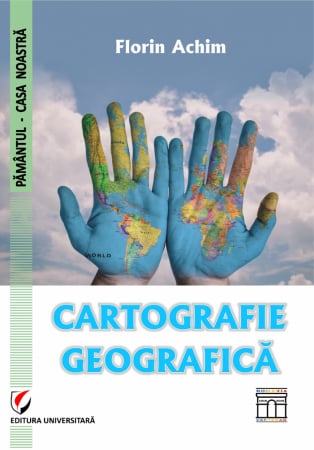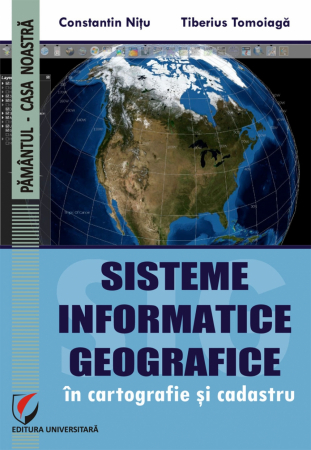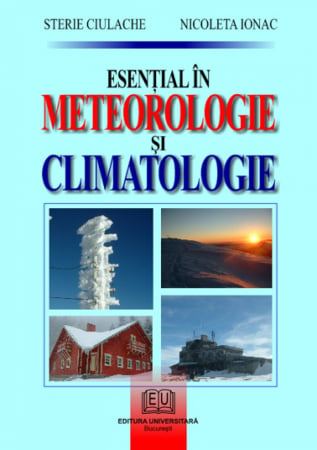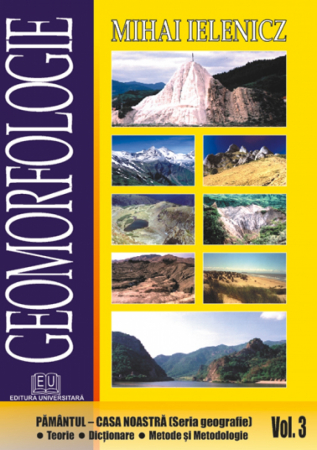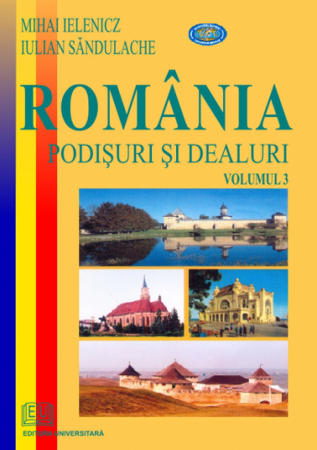ISBN: 978-606-591-128-4
Publisher year: 2011
Edition: II
Pages: 240
Publisher: Editura Universitară
Author: Ion Nicolae
- Description
- Download (1)
- Authors
- Content
- More details
- Reviews (0)
The pattern of human groups (how they are distributed / spread) classically approached by the geography of the population and settlements can be better and more correctly understood by paying attention:
- the way in which people ensure the necessities of life and life in general (field of economic geography);
- cultural and social values, group organization (field of cultural geography and social geography)
- concentrations in cities and metropolitan areas (domain / object of urban geography);
- their political organization at the level of the smallest settlements in the great empires and supranational political formations (object of political geography);
- health conditions, diseases that affect human groups (medical geography);
- the evolution of the spatial distribution (of the pattern) (field of historical geography).
-
Antropogeografie - O abordare diacronica
Download
Assoc. Dr., graduated in Geology - Geography in 1968.
Teacher in the University of Bucharest in 1969.
Ph.D. in Geography ("summa cum laude") in 1999.
Author of over 30 volumes, alone and together, from which emerges "Encyclopedia of world states" (first edition 1975, last, the tenth in 2005), regional geography volumes about the continents: Europe Encyclopedia (three editions the last in 2005), Encyclopedia of Asia, Australia and Oceania Encyclopedia (second edition), Encyclopedia of Africa, the Americas and works dedicated Encyclopedia exceptional elements present in the earth's surface including the first Romanian work on more than 800 targets included in UNESCO World Heritage Site (2005).
PART I. HUMAN GEOGRAPHY / ANTHROPOGEOGRAPHY. DEFINITION. THE NEED FOR HUMAN GEOGRAPHY. THE FIRST ELEMENTS OF HUMAN GEOGRAPHY (Greek and Latin / Roman antiquity and the Middle Ages) / 9
1.1. Introduction / 10
1.2. Definition. Domain, terms used to designate the geographical study of the company / 11
1.3. Emergence of human geography concerns (Greek antiquity) / 24
1.4. Human geography in the Middle Ages / 41
PART II. EUROPEAN EXPANSION (Great Geographical Discoveries) and HUMAN GEOGRAPHY. CONSOLIDATION OF GEOGRAPHICAL THEORY (Im. KANT, Al. Von HUMBOLDT, C. RITTER) / 55
2.1. The Great Geographical Discoveries - the revolutionary period in the history and geography of mankind / 56
2.2. Valorization and development of ancient geographical theory / 62
2.3. Immanuel Kant practitioner and theorist of geography / 72
2.4. Alexander von Humboldt and Carl Ritter the founders of modern geography / 85
PART III. HUMAN GEOGRAPHY / ANTHROPOGEOGRAPHY AND ITS FOUNDING PARENTS - Fr. RATZEL and P. VIDAL from BLACHE. MAJOR CURRENTS OF HUMAN GEOGRAPHY. CRISIS IN GEOGRAPHY / ANTHROPOGEOGRAPHY (1940-1950) / 113
3.1. Consolidation of modern geography / 114
3.2. Two "forgotten" geographers (anthropogeographers) (Elisée Reclus and Piotr Kropotkin) / 118
3.3. Charles Darwin revolutionizes geographical science / 123
3.4. Friedrich Ratzel - founder of modern anthropogeography. Determinism in human geography / 127
3.5. Regional direction in anthropogeography. Paul Vidal de la Blache and the French school of human geography / 146
3.6. The relations between the society and the environment - the perennial theme of geography / 156
3.7. Conclusions regarding the stage of anthropogeography / classical human geography / 160
PART IV POSTWAR HUMAN GEOGRAPHY. QUANTITATIVE REVOLUTION (NEW GEOGRAPHY) - ACHIEVEMENTS. MAIN MODELS USED (W.CHRISTALLER, T.HÄGERSTRAND s.a.). “NEW GEOGRAPHIES” (Radical geography, behavioral geography, feminist geography, etc.) / 169
4.1. Quantitative revolution in human geography / 170
4.2. Human geography in the last three decades / 196
PART V. HUMAN GEOGRAPHY / ANTHROPOGEOGRAPHY IN ROMANIA. GENERAL REFERENCES / 211
5.1. The beginnings of Romanian geography. Anthropogeographic aspects / 212
5.2. Romanian geographical school (anthropogeographic values) / 215
5.3. The development of Romanian anthropogeography / 220
5.4. Romanian anthropogeography during the communist period / 225
5.5. Romanian anthropogeography in the last two decades (indicative landmarks) / 232
SELECTIVE BIBLIOGRAPHY / 237
The pattern of human groups (how they are distributed / spread) classically approached by the geography of the population and settlements can be better and more correctly understood by paying attention:
- the way in which people ensure the necessities of life and life in general (field of economic geography);
- cultural and social values, group organization (field of cultural geography and social geography)
- concentrations in cities and metropolitan areas (domain / object of urban geography);
- their political organization at the level of the smallest settlements in the great empires and supranational political formations (object of political geography);
- health conditions, diseases that affect human groups (medical geography);
- the evolution of the spatial distribution (of the pattern) (field of historical geography).
We thus have in front of us an extremely elaborate (and yet incomplete!) Image of what human geography must study. How to go from the simple description and representation on the map of anthropogeographic objects (settlements, achievements of people "introduced" in the geographical environment that ceases to be seen as a natural one) to the analysis of the causes and effects of these spatial dispositions is a question which we find a satisfactory answer following the development and consolidation on a theoretical and methodological level of this particularly important and extremely dynamic branch of geography, a fact that we have followed in this volume.
First we have to clarify a problem only in the simple appearance, namely that of the name that must bear the major sequence of geographical science dedicated to man / society in its extremely varied spatial hypostases. It is accepted by most of the geographical world by virtue of a tradition on the verge of rooting in the Romanian post-December geography, the phrase human geography, name by which we find it in the curriculum of the first year students.
We will try in the following pages to show that another term, simple (with the appearance of a compound) would be more suitable in all aspects for the designation of the geographical study of mankind. In the conditions of lexical pragmatism specific to our times, the discussion may seem useless. Given the impetuous expansion of studies dedicated to the spatial presence (and action) of man / society - society's research is also included in the "portfolio" of other sciences - but a term is needed that does not leave room for confusion or misinterpretation.
(Anthropo) geographers differ from other specialists in the major questions they ask about society. Thus, after identifying and locating the geographical phenomena and objects in question (answering the first question of geography - where?) They seek to understand how? and why ? those human structures and activities (observed and mapped, most of the time) have developed, in the concrete ways observed, in certain places and not in others.
In order to answer satisfactorily and credibly (including in the eyes of others) geography (anthropogeography) must overcome its own "classical" condition; several models are provided by David Harvey (1973; 1989/2002), Edward W. Soja (1989; 2003), Derek Gregory (1978), Anne Buttimer (1993), geographers who, through their work, contributed to the successful penetration of geography in the circle of scientific debates regarding the ways of interpretation / explanation of modern society.
This insertion of geographers and geography in the contemporary world makes the debate on the title, the name of the field we serve (social spatiality) and indirectly the name with which we legitimize ourselves in front of other researchers (including colleagues who studies the physical and biological aspects of the earth's crust).
The study of the spatial / territorial aspects of man / society and mainly the analysis of society's relations with the environment, emerged in the second half of the 19th century as a "separate body in geography as a science" 4, giving it along time several names, the oldest (and for which we will militate in the following pages) being anthropogeography. By exaggerating the "contribution" of one of the terms of the environment-society relationship to outlining the specifics of a territory (space, area, area) it has arrived on the one hand to natural (or geographical, as it is commonly known) and on the other hand to determinism social, with its benign variant, possibilism (a more nuanced natural determinism).
The term anthropogeography appears in German literature in a general encyclopedia, published in 1842, in the context of the presentation of the article Erde (earth). The author - today forgotten - of this text and the proponent of the term so widely used for a long time, Ludwig Friedrich Kämtz, was undoubtedly under the strong impression of the extraordinary work of the time, Carl Ritter's Erdkunde, in which man and his actions they were well highlighted (we will present further, in part II, the merits of C. Ritter in the foundation of modern geography). Thus, some researchers consider that the de facto founder of anthropogeography is C. Ritter and not Fr. Ratzel. Our opinion is that, although we have this linguistic precedent, the merit of the enthronement, of imposing anthropogeography as a distinct branch of geography belongs to Friedrich Ratzel.

6359.png)
![Anthropogeography - A diachronic approach [1] Anthropogeography - A diachronic approach [1]](https://gomagcdn.ro/domains/editurauniversitara.ro/files/product/large/antropogeografie-o-abordare-diacronica-2099-62435.jpg)
